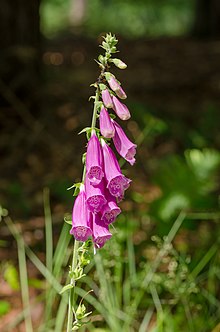Digoxin
| Structural formula | |||||||||||||||||||
|---|---|---|---|---|---|---|---|---|---|---|---|---|---|---|---|---|---|---|---|

|
|||||||||||||||||||
| General | |||||||||||||||||||
| Surname | Digoxin | ||||||||||||||||||
| Molecular formula | C 41 H 64 O 14 | ||||||||||||||||||
| Brief description |
colorless, four- to five-sided, triclinic plates |
||||||||||||||||||
| External identifiers / databases | |||||||||||||||||||
|
|||||||||||||||||||
| Drug information | |||||||||||||||||||
| ATC code | |||||||||||||||||||
| Drug class | |||||||||||||||||||
| properties | |||||||||||||||||||
| Molar mass | 780.94 g mol −1 | ||||||||||||||||||
| Physical state |
firmly |
||||||||||||||||||
| Melting point |
260–265 ° C (decomposition) |
||||||||||||||||||
| solubility |
very bad in water (0.065 g l −1 at 25 ° C) |
||||||||||||||||||
| safety instructions | |||||||||||||||||||
|
|||||||||||||||||||
| Toxicological data | |||||||||||||||||||
| As far as possible and customary, SI units are used. Unless otherwise noted, the data given apply to standard conditions . | |||||||||||||||||||
Digoxin is a naturally occurring chemical compound in the form of digitalis glycosides in foxglove species that has an effect on the heart muscle . Digoxin is one of the endogenous glycosides that act as hormones in mammals . Digoxin can be obtained from vegetable, primary digitalis glycosides by enzymatic hydrolysis as a secondary glycoside . In the compound three hexoses ( digitoxose ) are linked with the steroid aglycon digoxigenin . It differs from the structurally similar digitoxin in that it has a hydroxyl group on the C-12 of the aglycone.
history
Digoxin was first isolated from the leaves of Digitalis lanata in 1930 by Sydney Smith at Burroughs Wellcome in England .
effect
It shows a positive inotropic (increasing the force of contraction), negative chronotropic (lowering the heart rate), negative dromotropic (lowering the speed of the stimulus conduction) and positive bathmotropic (increasing excitability) on the heart. This results in an overall higher stroke volume, which results in better kidney blood flow and higher urine excretion.
The mechanism of action (if the potassium content in the blood is sufficiently high) is based on an inhibition of sodium-potassium-ATPase and therefore an increased calcium concentration in the heart muscle cells. In contrast to Digitoxin , the duration of action is shorter and the elimination occurs mainly via the kidneys.
The bacterium Eggerthella lenta inactivates digoxin by reducing the double bond in the lactone ring, which means that the glycoside loses its effect on the heart muscle.
indication
The main areas of application for digoxin are acute and chronic heart failure and supraventricular tachyarrhythmias such as atrial fibrillation (with rapid atrioventricular conduction) or atrial flutter. The effect of the drug (for example in an adult human with a dosage of 0.25 mg administered immediately and then 0.75 to 1.5 mg per 24 hours) is shown above all in a healthy heart muscle fiber. Because of this and because of better alternatives, digoxin has been displaced more and more from the market in recent years. A new study even shows that the death rate in patients with heart failure is higher with digoxin than with other preparations.
There is also evidence that the drug may inhibit prostate tumor growth.
unwanted effects
Digoxin has a narrow therapeutic window, which is why there are relatively frequent undesirable effects and poisoning. Loss of appetite, irregular heartbeat, nausea, vomiting, diarrhea, facial pain, headache, fatigue, weakness and drowsiness are common. Confusion, disorientation, perception disorders, psychoses, visual disturbances and abdominal pain occur less frequently.
In very rare cases, enlargement of the male mammary gland, cramps, hypersensitivity reactions and blood count disorders have been reported.
Trade names
Digacin (D), Lanicor (D), Lenoxin (D) and generics (D, CH)
Web links
- Entry on digoxin in Pharmawiki
Individual evidence
- ↑ a b c Entry on digoxin. In: Römpp Online . Georg Thieme Verlag, accessed on December 22, 2014.
- ↑ a b c d Entry on digoxin in the GESTIS substance database of the IFA , accessed on February 1, 2016(JavaScript required) .
- ↑ Hein, Lutz., Mohr, Klaus., Wirth, Jürgen .: Pocket Atlas of Pharmacology . 6., completely revised Edition Thieme, Stuttgart 2008, ISBN 978-3-13-707706-0 , p. 6 .
- ↑ W. Schoner, G. Scheiner-Bobis: Endogenous and exogenous cardiac glycosides and their mechanisms of action. In: American Journal of Cardiovascular Drugs . Volume 7, Number 3, 2007, pp. 173-189, PMID 17610345 . (Review).
- ↑ Spectrum of Science , November 2012, p. 33.
- ↑ Hermann Feldmeier: Microbiome: Vital turmoil in the intestine. Announcement in the Pharmazeutische Zeitung , issue 47/2012.
- ^ Anne Paschen: Heart. In: Jörg Braun, Roland Preuss (Ed.): Clinic Guide Intensive Care Medicine. 9th edition. Elsevier, Munich 2016, ISBN 978-3-437-23763-8 , pp. 185–283, here: p. 230.
- ↑ Reinhard Larsen: Anesthesia and intensive medicine in cardiac, thoracic and vascular surgery. (1st edition 1986) 5th edition. Springer, Berlin / Heidelberg / New York et al. 1999, ISBN 3-540-65024-5 , p. 55.
- ^ Anne Paschen: Heart. 2016, p. 230.
- ↑ JV Freeman, J. .. Yang, SH Sung, MA Hlatky, AS Go: Effectiveness and Safety of Digoxin Among Contemporary Adults With Incident Systolic Heart Failure. In: Circulation: Cardiovascular Quality and Outcomes. 6, 2013, pp. 525-533, doi : 10.1161 / CIRCOUTCOMES.111.000079 .
- ↑ Wissenschaft aktuell: Heart drug inhibits prostate cancer , accessed on April 4, 2011.
- ↑ Red List online, as of September 2009.
- ↑ AM comp. d. Switzerland, as of September 2009.
